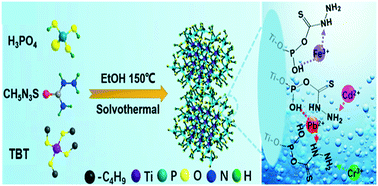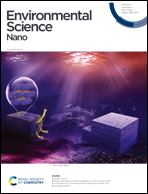Amorphous phosphated titanium oxide with amino and hydroxyl bifunctional groups for highly efficient heavy metal removal†
Abstract
Heavy metal pollution in water has become one of the main environmental problems in society today. Currently, traditional adsorbents can hardly reduce the heavy metal content in wastewater to trace levels to meet the standards for drinking water. Thus, it is urgent to design and construct new adsorption materials for the effective removal of heavy metals from sewage to trace levels. Herein, functional amorphous phosphated titanium oxide (FAPTO), a new adsorbent containing anchored organic (–NH2/–NH–) and inorganic (–OH) bifunctional groups on the surface, was synthesized via a simple one-pot solvothermal approach. The amino and hydroxyl groups within the matrix offer sorption sites for the capture of heavy metals. The obtained FAPTO effectively adsorbs heavy metals with uptake efficiency reaching 99.0%. FAPTO can remarkably reduce the Pb2+, Cd2+, Cr3+, and Fe3+ concentrations from ppm levels (∼5 mg L−1) to ppb levels (0.001–0.04 mg L−1), reaching the drinking water standards specified by the World Health Organization. Moreover, the Langmuir equilibrium isotherms indicate that the maximum sorption capacities of FAPTO for Pb2+, Cd2+, Cr3+, and Fe3+ are 761.3, 193.3, 255.2, and 166.1 mg g−1, respectively. Importantly, FAPTO possesses excellent reusability with negligible degradation after multiple reuses. The as-prepared FAPTO is a promising absorbent for heavy metal removal by virtue of its outstanding adsorption performance and eco-friendly fabrication process.



 Please wait while we load your content...
Please wait while we load your content...